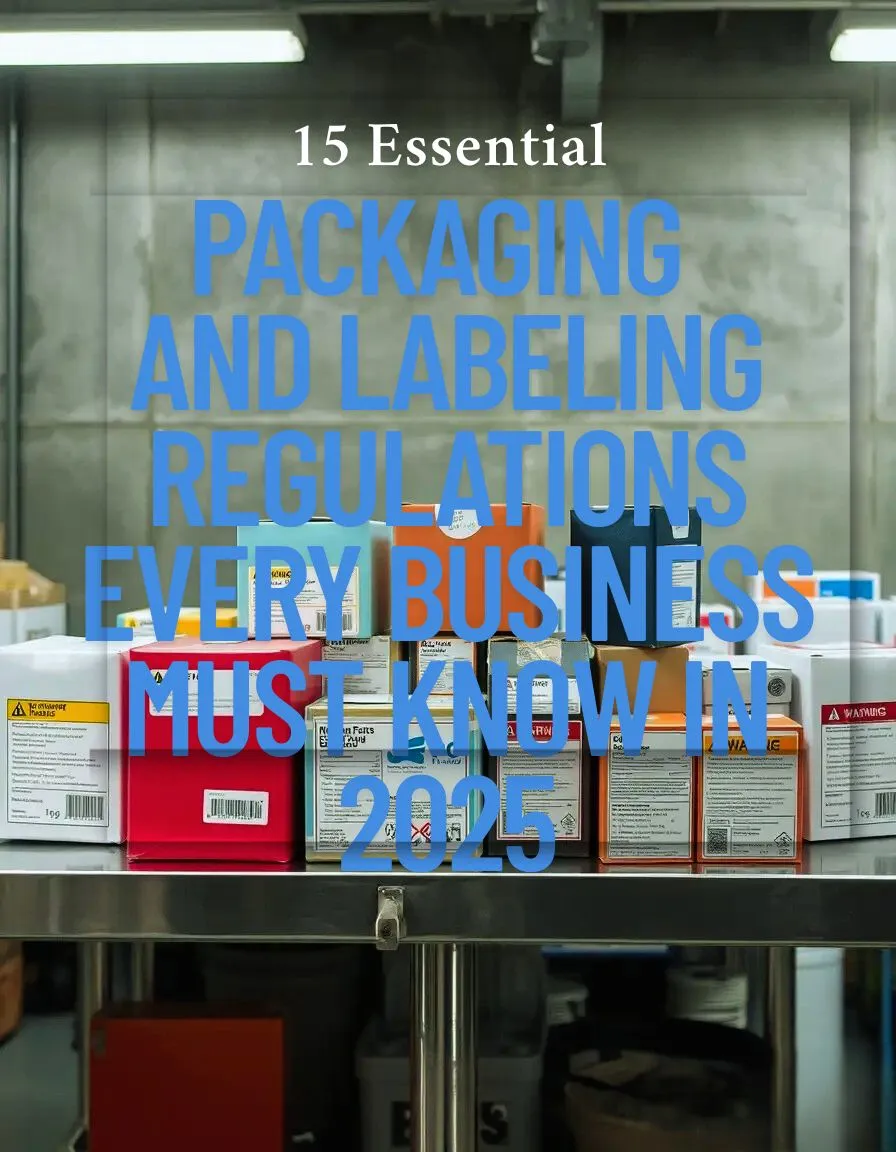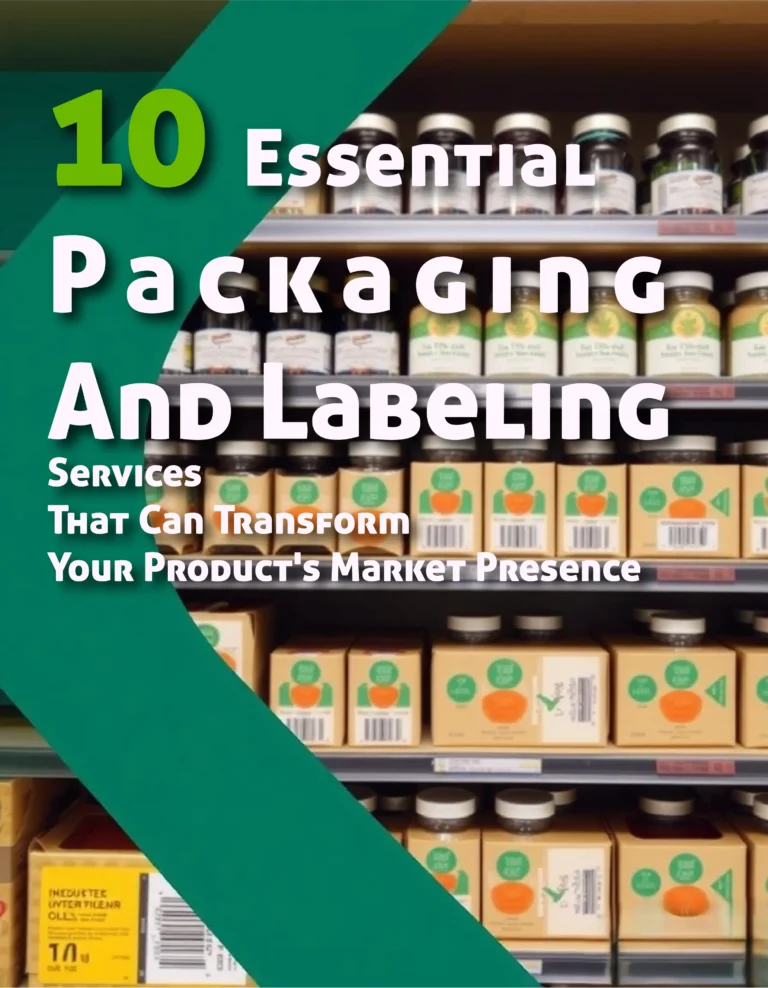
Picture this: You’ve just launched your dream product, invested months in development, and suddenly – boom! – a regulatory nightmare stops you cold. Your beautiful packaging doesn’t meet compliance standards, and now you’re facing recalls, fines, and a damaged reputation. Sound familiar? You’re not alone.
Packaging and labeling regulations aren’t just bureaucratic red tape – they’re the invisible guardians protecting consumers while keeping your business legally bulletproof. Whether you’re a food industry professional wrestling with FDA requirements or a cosmetics brand navigating EU standards, this comprehensive guide will transform you from regulatory rookie to compliance champion.
Let’s dive into the 15 most crucial packaging and labeling regulations that could make or break your business success.
- Learn more about our packaging design compliance services
1. Understanding the Regulatory Landscape: Who’s Running the Show?
Before we jump into the nitty-gritty, let’s get acquainted with the regulatory powerhouses calling the shots.
In the United States:
- FDA (Food and Drug Administration) – The ultimate authority for food, drugs, and cosmetics
- FTC (Federal Trade Commission) – Your go-to for non-food consumer goods
Internationally:
- EU Commission – Setting the gold standard for European markets
- Health Canada – Northern neighbor’s regulatory watchdog
- TGA (Australia) – Down under’s compliance guardian
Think of these agencies as your product’s passport control – they determine whether your goods get the green light or the red stamp of rejection.
- Discover our specialized pharmaceutical packaging solutions
2. Food Packaging Labeling Regulations: The Non-Negotiables
Food packaging labeling regulations are like a recipe – miss one ingredient, and the whole dish falls flat. Here’s what absolutely must appear on your food labels:
The Essential Eight:
- Product name (obvious, but you’d be surprised)
- Net quantity (weight, volume, or count)
- Ingredient list (in descending order by weight)
- Nutritional facts (the numbers everyone pretends to read)
- Allergen warnings (literally life-saving information)
- Manufacturer details (who to blame if things go wrong)
- Usage instructions (for those who actually read directions)
- Expiration dates (preventing science experiments in fridges)
Pro Tip: Don’t treat allergen labeling as an afterthought. With food allergies affecting millions globally, clear allergen disclosure isn’t just regulatory compliance – it’s a moral imperative.
- Explore our cosmetic label design portfoli
3. Pharmaceutical Packaging Regulations: Where Safety Meets Precision
If food packaging is strict, pharmaceutical packaging regulations are Fort Knox-level secure. The stakes? Human lives. No pressure, right?
Critical Pharmaceutical Requirements:
- Tamper-evident features (because trust, but verify)
- Child-resistant packaging (protecting curious little hands)
- Detailed usage instructions (dosage mistakes aren’t forgiving)
- Batch tracking information (for when recalls become necessary)
- Safety seals (your first line of defense)
« I once worked with a pharmaceutical company that nearly lost a $50 million product launch because their packaging failed child-resistance testing by mere seconds. Those extra safety measures aren’t suggestions – they’re survival strategies. »
- Check out our eco-friendly packaging option
4. EU Packaging and Labeling Regulations: The Green Revolution
European packaging regulations aren’t just about what’s inside – they’re revolutionizing how we think about sustainability. The EU’s approach combines consumer protection with environmental responsibility.
- View our safety and warning label designs
EU’s Triple Focus:
- Language Requirements – Clear, legible labels in official languages
- Environmental Standards – Recyclability and eco-design mandates
- Consumer Safety – Comprehensive ingredient disclosure
The Sustainability Twist: EU regulations now mandate minimum recycled content percentages. It’s not enough to be recyclable – you need to prove you’re using recycled materials too.
5. Cosmetic Packaging Labeling Regulations: Beauty with Brains
The cosmetics industry might be about looking good, but cosmetic packaging labeling regulations ensure you’re also doing good. These rules protect consumers from harmful ingredients while maintaining industry innovation.
Cosmetic Label Must-Haves:
- INCI (International Nomenclature of Cosmetic Ingredients) names
- Function/purpose statement
- Directions for use
- Precautionary statements
- Manufacturer information
- Batch identification
Reality Check: That 15-syllable ingredient name? It’s actually protecting you by using standardized international naming conventions.
6. Nutritional Labeling Requirements: Decoding the Numbers Game
Nutritional labeling requirements transform complex food science into consumer-friendly information. But getting these numbers right requires precision that would make a Swiss watchmaker proud.
The Nutritional Facts Panel Elements:
ComponentRequirementNotesServing SizeStandardized portionsBased on typical consumptionCaloriesPer servingIncluding calories from fatNutrientsDaily Value percentagesVitamins, minerals, macronutrientsAdded SugarsSeparate disclosureNew requirement emphasizing health
Insider Secret: The serving size isn’t what the manufacturer thinks you should eat – it’s based on actual consumption data. That’s why a « single serving » ice cream container might technically serve four people.
7. Sustainable Packaging Regulations: Going Green Isn’t Optional
Sustainable packaging regulations are reshaping entire industries. What started as environmental consciousness has evolved into legal requirements with real teeth.
The Green Compliance Checklist:
- Recyclable materials usage
- Minimum recycled content percentages
- Biodegradability standards
- Reduced packaging waste targets
- Eco-design requirements
Market Reality: Companies embracing sustainable packaging aren’t just following regulations – they’re winning consumer hearts and market share.
8. International Shipping Labels: Your Global Passport
When your products cross borders, they enter a complex web of international packaging and labeling standards. Each destination country has its own requirements, and ignorance isn’t bliss – it’s expensive.
Multi-Country Compliance Essentials:
- Language translations (accurate, not Google Translate)
- Measurement unit conversions (metric vs. imperial)
- Cultural sensitivity (colors, symbols, imagery)
- Local safety standards (voltage, chemical restrictions)
- Import documentation (certificates, permits)
« I’ve seen a perfectly compliant US product get rejected at Canadian customs because the French translation was grammatically incorrect. Details matter in international trade. »
9. Packaging and Labeling Compliance: Your Risk Management Strategy
Packaging and labeling compliance isn’t just about following rules – it’s about protecting your business from catastrophic failures. Non-compliance consequences include:
The Compliance Catastrophe Scale:
- Warning letters (your first and final warning)
- Product recalls (expensive and reputation-damaging)
- Financial penalties (fines that can bankrupt small businesses)
- Market exclusion (banned from selling in specific regions)
- Legal liability (lawsuits from harmed consumers)
Real Talk: The cost of compliance is always less than the cost of non-compliance.
10. Hazardous Material Labels: When Safety Isn’t Negotiable
Some products require specialized hazardous material labeling that goes beyond standard requirements. These regulations exist because the consequences of mistakes can be literally explosive.
Hazmat Labeling Essentials:
- UN identification numbers
- Hazard class symbols
- Proper shipping names
- Emergency contact information
- Handling instructions
Safety First: If you’re unsure whether your product requires hazmat labeling, consult experts. Guessing wrong isn’t worth the risk.
11. Medical Device Labeling Solutions: Precision Medicine Packaging
Medical device packaging combines pharmaceutical-level safety with technology-specific requirements. These products often save lives, so their labeling must be flawless.
Medical Device Label Requirements:
- Unique device identification (UDI)
- Sterility information
- Single-use warnings (where applicable)
- Biocompatibility statements
- Clinical performance data
Critical Point: Medical device labeling errors can result in FDA enforcement actions that shut down entire manufacturing operations.
12. Allergen Labeling Requirements: Life-Saving Information
Allergen labeling isn’t just regulatory compliance – it’s literally life-saving information for millions of consumers. These requirements have evolved significantly as our understanding of food allergies has improved.
The Major Allergen Eight:
- Milk
- Eggs
- Fish
- Shellfish
- Tree nuts
- Peanuts
- Wheat
- Soybeans
Best Practice: Use clear, simple language like « Contains: Milk, Eggs » rather than burying allergen information in ingredient lists.
13. Packaging and Labeling Laws: Staying Ahead of Changes
Packaging and labeling laws evolve constantly, driven by new scientific research, consumer advocacy, and technological advances. Staying current requires ongoing vigilance.
Regulatory Change Drivers:
- New safety data (emerging health risks)
- Environmental policies (sustainability mandates)
- Technology advances (smart packaging, QR codes)
- Consumer protection advocacy (lobbying for clearer labeling)
- International trade agreements (harmonized standards)
Strategic Advice: Subscribe to regulatory updates from relevant agencies. Being blindsided by new requirements is preventable.
14. Digital Integration: QR Codes and Smart Packaging
Modern packaging increasingly incorporates digital elements like QR codes that link to additional product information. While not always legally required, they’re becoming consumer expectations.
Digital Packaging Advantages:
- Extended information access (beyond physical label space)
- Multi-language support (cost-effective translations)
- Real-time updates (changing information without reprinting)
- Consumer engagement (interactive experiences)
- Traceability enhancement (supply chain transparency)
15. Future-Proofing Your Packaging Strategy
The regulatory landscape will continue evolving, with sustainability, transparency, and consumer safety driving changes. Smart businesses don’t just comply with current regulations – they anticipate future requirements.
Emerging Trends to Watch:
- Enhanced sustainability mandates
- Increased transparency requirements
- Digital-first labeling approaches
- Personalized nutrition information
- Blockchain integration for traceability
Your Compliance Action Plan
Ready to transform your packaging from regulatory liability to competitive advantage? Here’s your roadmap:
Phase 1: Assessment (Week 1-2)
- Audit current packaging against relevant regulations
- Identify compliance gaps and risks
- Prioritize issues by severity and market impact
Phase 2: Planning (Week 3-4)
- Develop compliance timeline and budget
- Select qualified suppliers and service providers
- Create testing and validation protocols
Phase 3: Implementation (Month 2-3)
- Execute packaging redesigns
- Conduct compliance testing
- Train staff on new requirements
Phase 4: Monitoring (Ongoing)
- Subscribe to regulatory updates
- Schedule regular compliance reviews
- Maintain documentation and records
The Bottom Line: Compliance as Competitive Advantage
Packaging and labeling regulations might seem like obstacles, but they’re actually opportunities. Companies that master compliance don’t just avoid problems – they build consumer trust, access global markets, and create sustainable competitive advantages.
The businesses thriving in today’s marketplace aren’t those trying to circumvent regulations – they’re the ones embracing compliance as a strategic differentiator. Your packaging tells your brand’s story, protects your consumers, and opens doors to new markets.
Ready to transform your packaging strategy? Start with a comprehensive regulatory audit, invest in quality compliance support, and remember – in the world of packaging and labeling, the details don’t just matter – they determine your success.
Your products deserve packaging that protects, informs, and inspires. Your consumers deserve transparency and safety. Your business deserves the peace of mind that comes from bulletproof compliance.
The choice is yours: Will you view regulations as barriers, or will you embrace them as the foundation for building a trustworthy, successful brand? The companies winning in 2025 have already made their choice.
Need personalized guidance on packaging and labeling compliance for your specific industry? Connect with regulatory experts who can transform compliance challenges into competitive advantages. Your success story starts with the right packaging strategy.
- Ready to get started? Contact our packaging experts
- Browse our packaging design gallery
- FDA Resources:
- « According to FDA packaging guidelines«
- « The FDA’s Code of Federal Regulations«
- EU Commission:
- « EU packaging regulations outlined in European Commission guidelines«
- FTC Guidelines:
- « FTC requirements detailed in their advertising and marketing guide«
Industry Resources:
- Packaging Industry:
- « Industry standards from Packaging Machinery Manufacturers Institute«
- « Best practices by Sustainable Packaging Coalition«
- Food Safety:
- « Food safety guidelines from FDA Food Safety Modernization Act«
- International Standards:
- « ISO packaging standards at International Organization for Standardization«
Research and Data:
- Market Research:
- « According to Grand View Research packaging market report«
- Environmental Impact:
- « Environmental data from Ellen MacArthur Foundation


